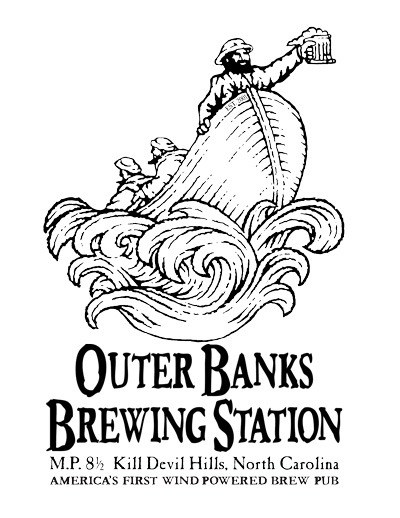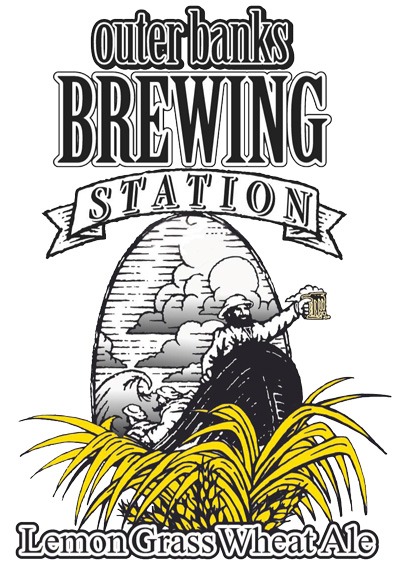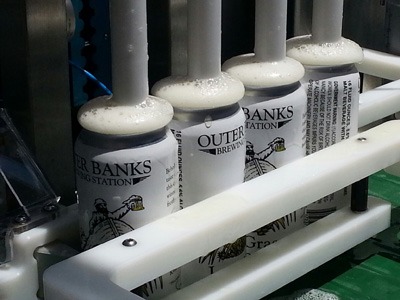Outer Banks Brewing Co.
Dear Replicator,
My family has traveled to the Outer Banks of North Carolina for many years for our family vacation and we found this brewpub, the Outer Banks Brewing Station in Kill Devil Hills, North Carolina, three years ago. We tried their LemonGrass Wheat Ale and it was amazing. I bought a growler and 6-pack to take back to the house for the rest of the week, however, it did not last that long. My wife of 19 years, Emily, was not a big beer drinker but she really loved this beer.
Last April we lost Emily to bile duct cancer at the age of 41. I stopped brewing for a while prior since she was going through treatments. I started brewing again about six months ago and I have tried to replicate this beer a couple times. I have not hit the mark. Please help me with this recipe and help me continue to remember the last year we had with her on the beach, smiling, laughing, and having a great family vacation with our toes in the sand and a great refreshing beer in our hands.
Joe Eberhardt
Bethlehem, Pennsylvania
I’m extremely sorry to hear what you’ve had to go through recently Joe, but I’m glad that you contacted me about the beer. You’ll be able to take solace in that the recipe comes straight from the “Head Janitor,” Eric Reece of Outer Banks (OBX) Brewing Station who’s been brewing this beer for a while now at their location in Kill Devil Hills, North Carolina.
But our story doesn’t begin in North Carolina but rather across the continent in San Francisco. Eric and Aubrey Davis felt the separate calling of the Peace Corps following college. It was during that time that the two were pulled together during training in California. Eric’s background was in applied physiology and he was interested in finding ways for primary schools to generate income in underdeveloped countries while Aubrey’s interest centered on water projects. Following training, the two were deployed to Thailand along with a future OBX Brewing Station player, Tina Mackenzie.

Following the three’s immersion training with local families, Tina and Eric headed north while Aubrey went south to execute their own particular projects. Aubrey’s project had a particular impact on him and the Brewing Station to come. He was working with local rangers to implement a solar array that would provide power to remote ranger stations that needed to charge communication devices. Without that capability, the rangers had to operate in a bubble, without back-up, which was problematic when foreign fishermen were trespassing into Thailand’s rich fishing grounds. Additionally, the raiders used dynamite and cyanide-based poisons to rapidly harvest thereby polluting the grounds for future generations.
When their stints were up in 1993 with the Peace Corps, they traveled back to the U.S. but separated. Eric quickly realized the corporate world wasn’t a good fit for him and left it for work at his local Berkeley, California brewery, Bison Brewing, despite taking a 70% pay cut. But when Bison closed its doors (remember these were the fledging times for the new microbrewery industry), the Brewmaster Scott Meyer carried Eric along for the ride to a winery where he managed the crush. Meanwhile, Aubrey was working night and day in the White House’s bomb shelter as part of the “greening of the White House” under then President Clinton. In his spare time, he took up homebrewing as a hobby.
This common thread of brewing would be brought up during a phone conversation in 1997. Before long, their nascent idea of opening a merchandise store, an idea hatched in Thailand, was morphing into a brewpub. The location? . . . the OBX. They were thankful for their supporters and raised enough capital to purchase a sizable plot in Kill Devil Hills. But a larger parcel meant a larger pub that could provide enough revenue to offset the corresponding costs. Eric and Aubrey engaged with local experts to make their dream become a reality including an Outer Banks Chamber of Commerce’s program made up of a group of volunteer, retired executives that help budding entrepreneurs build viable business plans, as well as Ron Bennett from Self Help Credit Union alongside Wachovia Bank, and finally Ben Cahoon, who was the architect.
According to Eric, “The brewing station has evolved over the years into a fusion of passions that have been guided by our community’s needs: Part culinary expression of our ‘American beach fusion’ style (featured on Diners, Drive-Ins, and Dives and Guy Fieri’s family reunion where we hosted his family dinner), to brewing quality beers (multiple medals from major competitions although we rarely enter), to finally engendering climate discussion (our 10 kW wind turbine on-site), because myself, my partner Aubrey Davis, and my wife (the baker) Tina Mackenzie all having been in Peace Corps Thailand together.” They also support “. . . community involvement — countless fundraisers, actual marriages, numerous proposals, and beach cleanups. We are a surfriders spot — known as the Beer Church up and down the East Coast.”
I hope this article’s background about the OBX Brewing Station gives you, Joe, even more of an appreciation of the location and its background as well as the knowledge to re-create your late wife’s love for this beer and to carry on those memories that you’ve made. Good luck brewing up this LemonGrass Wheat Ale and to all who desire to create their own, new memories. Cheers!
Outer Banks Brewing Station’s Lemongrass Wheat Ale clone

(5 gallons/19 L, all-grain)
OG = 1.050 FG = 1.012
IBU = 17 SRM = 4 ABV = 4.9 %
Ingredients
5.5 lbs. (2.5 kg) wheat malt
4 lbs. (1.8 kg) Pilsner malt
0.25 lb. (113 g) CaraHell® malt (10 °L)
0.25 lb. (113 g) Vienna malt
0.1 lb. (45 g) acidulated malt
4.5 AAU Liberty hops (60 min.) (1 oz./28 g at 4.5% alpha acids)
5 oz. (142 g) fresh, smashed lemongrass (0 min.)
Wyeast 3068 (Weihenstephan Weizen), White Labs WLP300 (Hefeweizen Ale), or SafAle WB-06 yeast
1 cup corn sugar (if priming)
Step by Step
Mill the grains, then mix with 3.2 gallons (12 L) of 169 °F (76 °C) strike water to achieve a single infusion rest temperature of 153 °F (67 °C). Hold this temperature for 60 minutes. Mashout to 170 °F (77 °C) if desired.
Vorlauf until your runnings are clear before directing them to your boil kettle. Batch or fly sparge the mash and run-off to obtain 6.5 gallons (24.6 L) of wort. Boil for 60 minutes, adding the Liberty hops at the beginning of the boil. No need to add any fining agents as this is meant to be a cloudy beer.
After the boil, add the fresh lemongrass and rapidly chill the wort to at least 68 °F (20 °C). Pitch yeast, then maintain this temperature for the duration of active fermentation.
Once primary fermentation is complete and the beer has settled, bottle or keg the beer and carbonate to approximately 3.0 volumes.
Outer Banks Brewing Station’s Lemongrass Wheat Ale clone
(5 gallons/19 L, extract only)
OG = 1.050 FG = 1.012
IBU = 17 SRM = 5 ABV = 4.9%
Ingredients
4 lbs. (1.8 kg) wheat dried malt extract
1.5 lbs. (0.68 kg) Pilsen dried malt extract
½ tsp. 88% lactic acid
4.5 AAU Liberty hops (60 min.) (1 oz./28 g at 4.5% alpha acids)
5 oz. (142 g) fresh, smashed lemongrass
Wyeast 3068 (Weihenstephan Weizen), White Labs WLP300 (Hefeweizen Ale), or SafAle WB-06 yeast
1 cup corn sugar (if priming)
Step by Step
Warm 6.5 gallons (25 L) of water to roughly 150 °F (66 °C). Add the two types of extract and lactic acid, with stirring, before heating to a boil. Return to heat once all the extract is dissolved. Boil for 60 minutes, adding hops at the beginning of the boil. No need to add any fining agents.
After the boil, add the fresh lemongrass and rapidly chill the wort to at least 68 °F (20 °C). Pitch yeast. Maintain this temperature for fermentation. Once primary fermentation is complete and the beer has settled, bottle or keg the beer and carbonate to approximately 3.0 volumes or as high as your draft/bottle pouring system will allow.

Tips for Success:
This recipe is best brewed as an all-grain version as the nuances provided by the CaraHell® and Vienna malt aid in producing a mildly complex malt profile. Water chemistry should be fairly neutral with neither chlorides nor sulfates being emphasized. Finally, use the freshest lemongrass that you can find; pinch it and smell your fingers, it should have a citrus, ginger aroma. Similarly, don’t forget to crush the lemongrass before adding it to the end of the boil as masticated lemongrass releases substantially more oil into the brew.



